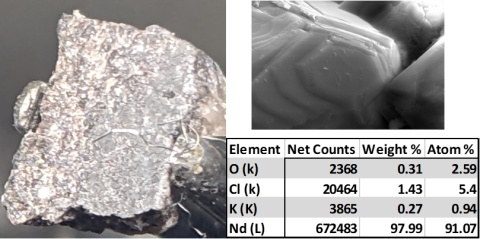
CMI researchers from Case Western Reserve University conducted the research for this highlight.
Innovation
Development of an electrode that enables stable and energy-efficient Nd electrowinning, and a novel electrolyte to achieve high Nd purity.
Achievement
Use of proprietary dimensionally-stable anode (“G-RuO2“ DSA) enables stable, energy-efficient Nd electrolysis from chloride melts with no CO2 or PFC emissions. Nd purity of 98 wt% achieved.
Significance and Impact
Results confirm that the proposed chloride molten salt route (patents pending) enables sustainable (CO2-free) and efficient production of high-purity Nd.
Hub Goal Addressed
Development of sustainable, scalable rare earth metals production capability.

